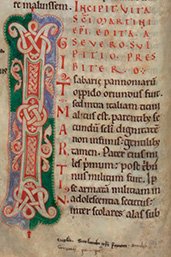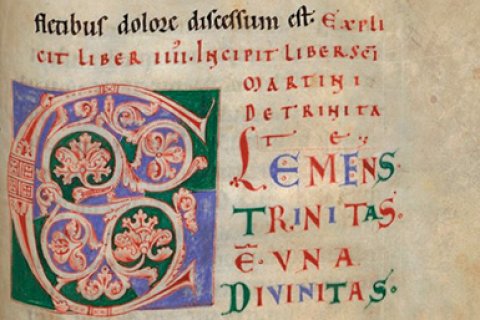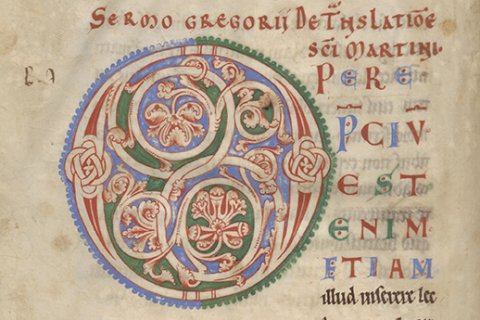Martinellum
Saint Martin of Tours

Manuscript 124 is a Martinellum: a collection of texts about Saint Martin of Tours (316/317-397), of which the Vita Sancti Martini by Sulpicius Severus is the most important.
The Martinellum had a role within the liturgy, the church services in which Saint Martin was an important saint. It was one of the precursors of the missal, a book containing, among other things, the lessons to be read on certain saint’s days. Certain passages of the Martinellum were read aloud on Saint Martin’s Day (11 November) and on the day commemorating the ‘translatio’ of his bones, when they were taken to Tours (4 July).
Saint Martin as a patron saint

Soon after his death Martin became a very popular saint. Many churches and cloisters are named after him and he is the patron saint of many cities. This is also true of Utrecht, where the cathedral is dedicated to him.
The twelfth-century Martinellum mentioned here was the property of this cathedral. On folio 1r a note in handwriting from the fifteenth-century reads Liber de historia Sancti Martini patroni nostri gloriosi, cathenatus In choro ecclesie nostre Trajectensis (‘Biography of Saint Martin, our glorious patron saint, chained in the choir stalls of our church in Utrecht’).

This demonstrates that the manuscript was kept chained to the choir stalls in the cathedral. The book shows traces of the fastening.
Martinellum decorations
Ms. 124 is not the only Martinellum in the Utrecht University Library collection, which also includes a twelfth-century Martinellum (Ms. 122). The text of both is almost identical to the southern German copy in Leiden University Library (Cod. Voss. Q.74) from the first half of the eleventh century, which was donated to St Peter of Utrecht by Bishop Bernold (1027-1054).
However, these Utrecht manuscripts are not copies of this Leiden codex. The Utrecht manuscripts are likely to be a copy of a Martinellum which Bernold may have donated to the cathedral. While Mss. 124 and 122 do not include miniatures, they do have initials and are two of the very few examples of codices written and illuminated in the northern Netherlands in the twelfth century.
Ms. 124 includes the handwriting of five different people, in a pre-Gothic script or littera pregotica. The manuscript also includes rubrics of red lombard initials and the first words of each text are written in alternating red, green and light-blue lombard initials.

These colours are also used for the sixteen large initials marking the beginnings of the texts. The initials are depictions of tendrils, containing interwoven embellishments and leaf and flower motives reminiscent of the style of an earlier (Romanesque) period. The page shown here (fol. 124v) includes a beautifully created ‘O’, the first initial of a sermon by Gregory of Tours (c. 538-594) on the ‘translatio’ of St Martin mentioned above.
Author: Bart Jaski, 2011


